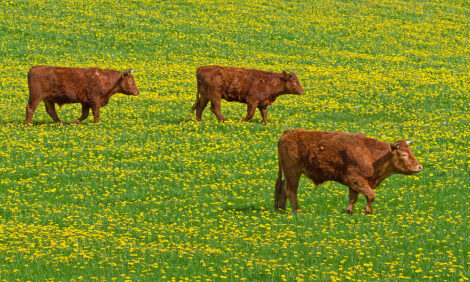



Tackling ticks through DNA
A new study indicates that eradication of the cattle tick in Australia is theoretically feasible.Globally, the annual economic loss from cattle ticks is estimated to be US$22-$30 billion.
A new University of New England (UNE)-initiated study has established the feasibility of breeding tick resistance into all cattle, even Bos taurus breeds.
The ability to breed for tick resistance, used with other measures, suggests that eradication of cattle tick in Australia may be feasible.
The study interpreted genomic data drawn from multiple breeds across several nations, a world-first that greatly expands the practicality of genomic approaches to modifying cattle traits.
A ground-breaking multi-nation study has shown that breeding strong tick resistance into all cattle breeds is feasible, indicating that cattle tick may be much more effectively managed, or even eradicated.
Dr Heather Burrow, a University of New England (UNE) professorial research fellow, initiated the project that found there is proof-of-concept for using the cattle genome to tackle a pest that costs the Australian cattle industry more than $175 million a year.
Researchers from Brazil, Australia, South Africa and Scotland contributed to a multi-nation, multi-breed analysis – a first of its kind – which concluded that genomic breeding values can be estimated across a wide range of unrelated cattle breeds and used to improve tick resistance.
The approach to the world-first study was proposed by Professor Ben Hayes of the University of Queensland, a co-inventor of the genomic selection methodology and a key researcher on the tick project. He had successfully used the approach for across-country evaluations of feed efficiency in dairy cattle.
The tick resistance project has lowered two substantial hurdles for the cattle industries: managing cattle tick, and drawing practical conclusions from multi-breed, multi-nation genomic data.
"For many decades there was a lot of science directed at finding a solution to cattle ticks, but by the mid-1990s it just all looked to be too hard and expensive," said Dr Burrow, a former chief of the Beef Cooperative Research Centre.
"This study indicates that for a relatively small amount of money, we can use genomic technologies to develop a real solution to cattle ticks.'
Globally, 80 per cent of the world's cattle are at risk of tick-borne diseases. The economic loss from cattle ticks worldwide is estimated to be US$22-30 billion per annum.
In Australia, and globally, the range of cattle ticks is expanding as the planet warms. As a result, the range is shrinking for cattle breeds with low tick resistance — which includes all the Bos taurus breeds that underpin Australia's high-value beef export markets.
The study that has excited Dr Burrow was led by Brazilian researcher Dr Fernando Cardoso of the Embrapa Pecuária Sul (Brazilian Agricultural Corporation) at Bagé, and involved a large cast of scientists from the Roslin Institute in Scotland, UNISA and ARC in South Africa, the University of Queensland, CSIRO, and Dr Burrow herself.
To arrive at the conclusion that universal tick resistance was possible through genomic breeding tools, the study achieved a world-first multinational genomic assessment of multiple unlinked cattle populations.
Until now, Dr Burrow explained, genetic assessment has relied on having cattle populations that were genetically linked and carried records documenting those linkages.
The Cardoso study instead used a mathematical process that allowed relatively cheap low-density chips to represent the whole cattle genome. With the full genome to work with, scientists didn't need the usual genetic linkages to make their assessment.
Thousands of cattle from seven breeds — from Angus and Braford in Brazil to Tropical Composites in Australia and Nguni in South Africa — were tested for their responses to ticks and the results pooled and analysed.
The researchers reported that there is strong evidence of the heritability of tick resistance across all breeds, an important foundation on which future tick resistance can be built.
Not unexpectedly, the heritability of tick resistance is strongest among Bos indicus breeds like Brahman and Braford, but the fact that heritability exists in Bos taurus breeds indicates room for improvement among cattle now highly vulnerable to ticks.
Dr Burrow believes the next stage is to identify more practical, cost-effective measurements of cattle tick resistance through a short-term study of different methods identified by a recent comprehensive review of the scientific literature. More cost-effective methods of measuring tick resistance will greatly enhance the likelihood of tick resistance being included in genetic improvement programs globally.
If this becomes feasible, then Dr Burrow believes that not only can cattle be made much less vulnerable to cattle ticks, but that the tick might even be eradicated in Australia.
"If we could eradicate brucellosis and tuberculosis, I can't see why we couldn't eradicate cattle tick," she said.
"The simplest way would be through breeding, but we could take advantage of vaccines and quarantine lines. Australia has a unique ability to take on that sort of ambition because we do not have wildlife that harbour ticks – as is the case in most other countries – which would give our beef and dairy industries a unique advantage.
Image: University of New England Professor Heather Burrow has spent her distinguished career researching how producers can get improved productivity from cattle.


